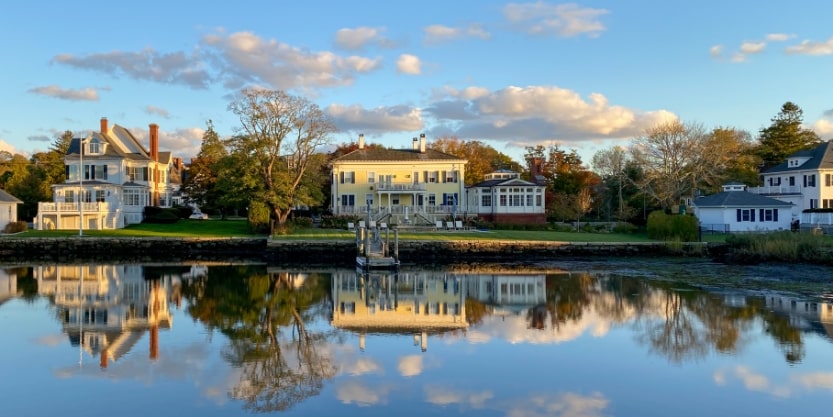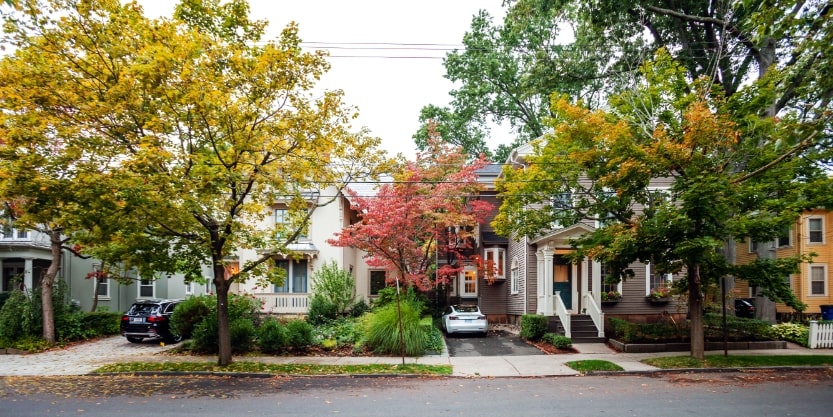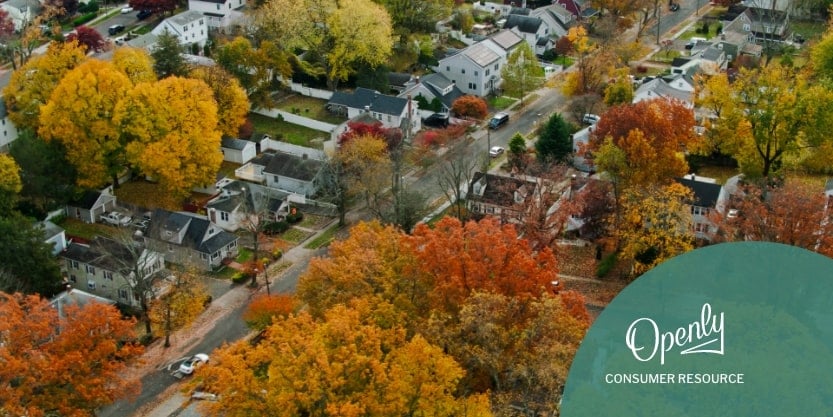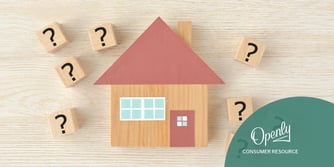The northeastern states are known for their picturesque environment, rich history, and quaint towns, all contributing to this region’s unique charm. However, with the region’s beauty also comes potential home safety risks.
From severe weather to natural disasters, there are several factors that can put homes at risk in the northeast. And with home insurance premiums ranging from an average of $1,372 to north of $5,400 annually, it’s important to be certain that your insurance coverage meets your needs, without risking your financial stability.1
Read on to learn more about home insurance risks common in the Northeastern United States and how to protect your home and family against disaster.
At a glance:
-
With insurance premiums ranging starting at an average of $1,372, it's important that your insurance coverage meets your needs and protects you against regional threats.
-
Weather and climate hazards like snowfall, hurricanes, and flooding require tailored coverage solutions.
-
Implement actionable measures like policy reviews, risk assessments, and regular home maintenance to ensure comprehensive protection for your home.
Weather hazards
Unpredictable weather isn’t uncommon in the northeast, given its hot summers and cold winters. While this may make for a diverse, or interesting climate, some might say, it also brings with it a variety of weather hazards that can damage your home.
One of the most common weather hazards in the Northeast is snowfall. Heavy snowfall can lead to collapsing roofs, ice dams, frozen pipes, and more; all of which can cause significant damage to your home, both inside and out. And it isn’t just snow that is a risk to your home; strong winds, heavy rain, and hail can all cause damage to your roof, siding, and windows.
To protect your home from these hazards, it's important to regularly inspect and maintain your roof, gutters, and siding. Check for any gaps around flashes, outlets, and windows. Don’t neglect to inspect your attic and basement for vulnerable areas, insulation gaps, or water seepage. You may also want to consider investing in a backup generator as a preventative measure in case of power outages during severe weather.
Natural disasters
While natural disasters—like seismic activity—may not be common in the northeast, they can still occur and cause significant damage to your home.
Some of the common natural disasters that can occur in this area include:
- Hurricanes, which can bring strong winds, heavy rainfall, storm surges, and flooding
- Nor'easters (or strong coastal storms that can cause heavy snowfall), wind gusts, coastal flooding, and power outages
- Winter storms, such as blizzards and ice storms, which result in hazardous conditions
- Tornadoes which can destroy homes, uproot trees, and cause widespread devastation
Although severe weather like tornadoes may be rare, they aren’t unheard of in the northeast. To protect your home from natural disasters, it's important to have appropriate insurance coverage. Be sure to carefully review your home insurance policy to understand any coverage limitations or exclusions to weather- and climate-related perils.
Home safety risks
Now that we've covered potential hazards, let's take a closer look at specific home insurance risks and factors to keep in mind.
Flooding
Flooding is a common risk to a Northeastern home, such as in the spring when snow melts and heavy rains occur. Due to a number of factors, such as the proximity to the coast, lakes, and rivers, as well as general topography, this region is unfortunately prone to flooding.
Homeowners should also take note that most standard home insurance policies don't cover flood damage so additional coverage may need to be purchased to protect their homes and belongings.
Mold
Mold and fungi are common in northeastern states because of the region's high humidity levels and frequent rainfall. These environmental factors foster mold growth, which can pose a significant threat to your home and health. Mold can cause damage to your home's structure, including walls, ceilings, and floors, especially in basements, attics, or bathrooms. Mold can do more than damage your dwelling; it can also lead to health problems, like respiratory issues or allergies.
To protect your home from mold and fungi issues, it's important to regularly inspect your home for any signs of mold growth and address them as soon as possible. Unfortunately, not all standard home insurance policies cover mold damage, but some insurance providers may offer mold coverage as an optional add-on. Ask your insurance company about mold coverage endorsements, limits, and exclusions.
It’s worth noting that there are insurance agencies that include mold and fungi coverage as part of their standard home insurance policy, like Openly. So if you live in a particularly damp or humid environment, and are concerned about mold growth, ask your local independent agent about Openly home insurance.
Frozen pipes
Frozen pipes are also a common issue in the northeast during the winter months. Frozen pipes can burst, causing significant water damage to your home.
While most homeowners insurance covers this type of damage, it's important to be proactive. To prevent frozen pipes, insulate both interior and exterior pipes, allow faucets to drip in severe cold weather, and keep the home heated to a consistent temperature.
Typically, home insurance takes care of damages from burst pipes, which can include pipe repair and water damage mitigation. However, it's essential to understand the specifics of your policy regarding frozen pipes; some policies may have limitations on coverage or require certain preventative measures to be in place.
Power outages
Severe weather can cause power outages because of impacts to the power grid. While many homeowners insurance policies do not typically cover the cost of spoiled food if the power goes out, you may be able to purchase additional coverage. Additional coverage in the form of refrigerated property or food spoilage coverage can help reimburse you for the cost of spoiled food due to a power outage.
Review your home insurance policy to see if you have coverage for power outage-related spoiled food included, or to make an informed choice when buying supplemental refrigerated property coverage.

How to protect your home and family
Below are tips for minimizing risks and ensuring you maintain adequate coverage to suit your unique needs.
Review your policy
The first step in protecting your home is to review your current homeowners insurance policy. It's important to understand what is covered by your home insurance and what is not covered by your homeowners policy. If you have any questions or concerns, reach out to your insurance agent for more information.
Perform a risk assessment
A risk assessment identifies potential threats and vulnerabilities associated with your property. This assessment helps identify and mitigate potential risks, ensuring you have adequate coverage. Be sure to analyze environmental hazards, structural integrity, and any other relevant elements of your home and personal belongings.
Purchase additional home insurance coverage
If you live in an area prone to flooding, earthquakes, or other natural disasters, consider purchasing additional coverage to protect your dwelling and personal belongings.
Regularly inspect and maintain your home
Regularly inspecting and maintaining your home can help prevent damage and minimize risks. Examine your roof, gutters, and pipes for any problems, and make repairs as necessary. Contact your insurance agent if you discover any serious issues requiring professional intervention; they may be able to make recommendations for trusted mitigation and repair vendors.
Reduce the risk
Living in the northeast comes with its own set of unique risks and hazards. Identifying home safety risks and implementing measures to safeguard your family can help you reduce the chances of damage to your home and belongings.
Don't forget to regularly review your policy and make any required changes to guarantee sufficient protection for your house. Stay safe and enjoy all that this stunning region has to offer!
* We provide this information to help you understand insurance. Any coverage is subject to the terms of your policy. Please refer to your policy and declaration page for complete coverage details.
1 Mark Fitzpatrick. “Average Cost of Homeowners Insurance in Connecticut (2024).” MoneyGeek. Published 14 February 2024. Accessed 1 March 2024. https://www.moneygeek.com/insurance/homeowners/average-cost-home-insurance-connecticut/




